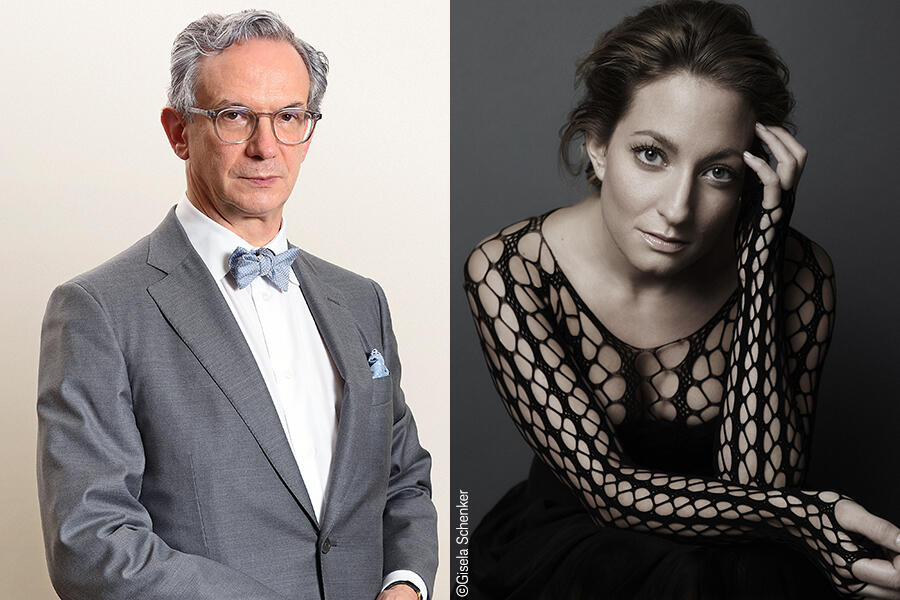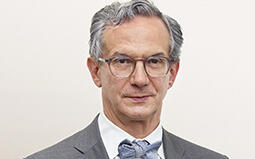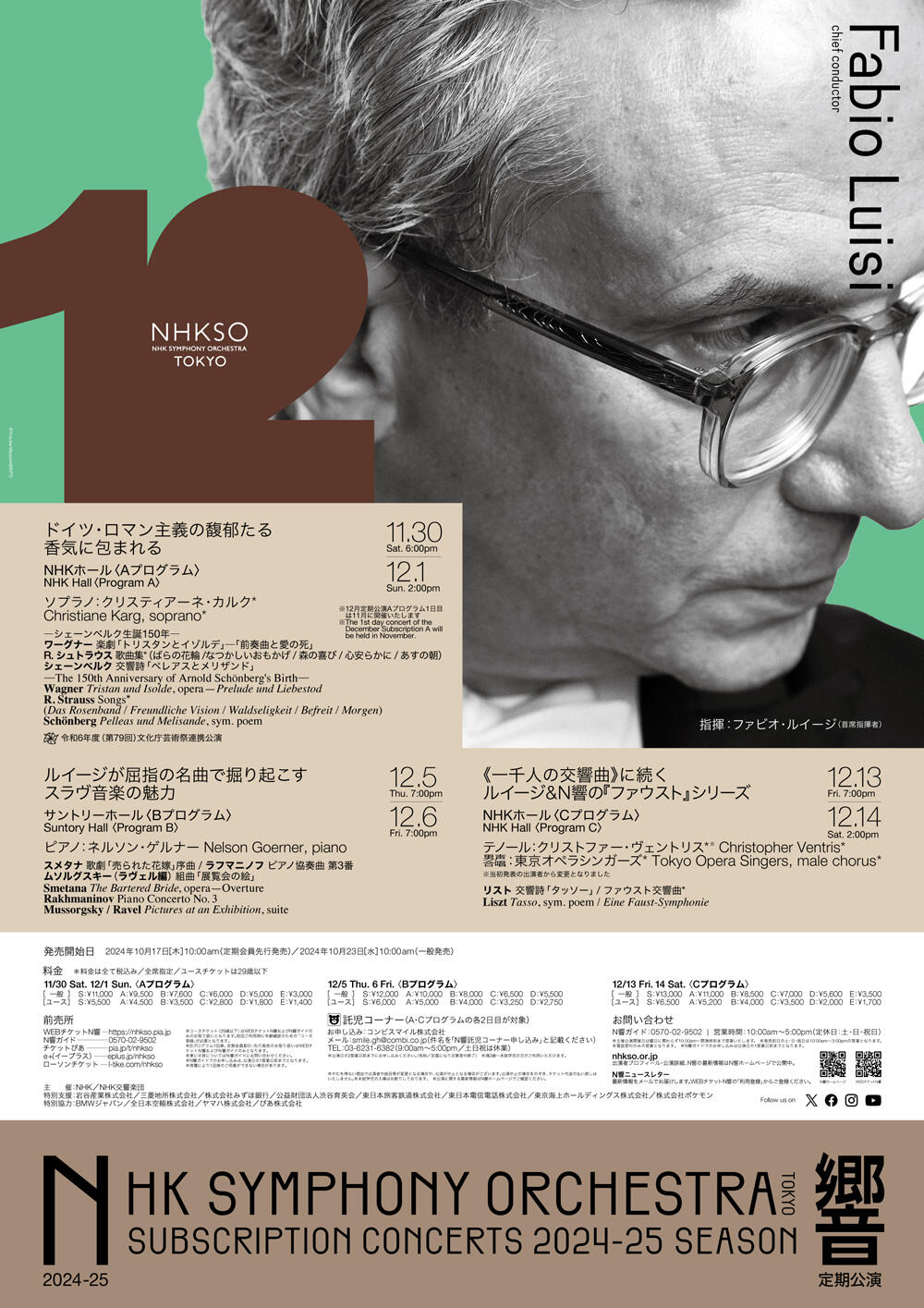- Home
- Concerts
- Subscription Concerts 2024-2025
- Program A
- No. 2025 Subscription (Program A)
No. 2025 Subscription (Program A)

Program
Wagner / Tristan und Isolde (Tristan and Isolde)—Prelude and Liebestod
A pivotal figure in the history of opera, Richard Wagner (1813–1883) founded Musikdrama (music drama) as represented by his Tristan und Isolde (Tristan and Isolde) (1859). In this operatic genre for which he wrote both libretto and music, the drama and the music are indissolubly united on an unprecedented level, especially by the scrupulous use of the leitmotifs (recurrent melodic or/and harmonic elements representing certain situations, feelings or so). Tristan und Isolde is about the forbidden love between the knight Tristan and his uncle’s wife Isolde. The Prelude to Act 1 foretells the tragic and sensual nature of the story with chromatic, ever-lasting melodies and opulent orchestral sound. The first chord heard at the outset is dissonant and unresolved: so-called “Tristan Chord,” this is considered in music history a principal which lead the traditional tonal harmony to ruin. Liebestod (Love-death) is sung by dying Isolde at the last scene, after Tristan was killed by Isolde’s jealous husband. The final B-major chord suggests that their love comes to fulfillment upon their death.
[Kumiko Nishi]
R. Strauss / Das Rosenband Op. 36-1 (The Rose Chain)*, Freundliche Vision Op. 48-1 (A Welcome Vision)*, Waldseligkeit Op. 49-1 (Bliss in the Woods)*, Befreit Op. 39-4 (Released)*, Morgen Op. 27-4 (Tomorrow)*
Richard Strauss (1864–1949) was a precocious musical genius. The son of the principal French horn player at the prestigious Munich Court Orchestra, he began to take piano lessons at age 4 and to compose at age 6 before starting to learn violin at age 8.
Guided by his father’s conservative musical taste, Strauss’s earliest compositions were modeled after Haydn, Mozart, Beethoven and Schubert. However, from 1880 when the mid-teenage composer studied the score of the above-mentioned opera Tristan und Isolde, he gradually deepened his adoration for Wagner. Voluptuous chromatic harmony, large-scale orchestra and the feeling of endlessness are some of the trademarks of Wagner’ music: almost all topflight composers of his and coming generations couldn’t skirt the problem of how to absorb and/or break away from his style. As for Strauss, his enthusiasm for Wagnerian late-Romanticism came to the climax with the opera Salome (1903–1905).
Besides fifteen operas, Strauss completed over two hundred songs during his exceptionally long productive career. One of his sources of inspiration was the soprano Pauline, whom he married in 1894. The couple also gave duet concerts together promoting his songs in various places. The fact that Pauline retired from singing in 1906 more or less influenced Strauss’s career as a song composer from that time forth. The five songs selected for today’s concert were penned for voice and piano before 1901, and Strauss himself prepared the orchestral accompaniment versions of the all five.
Das Rosenband (The Rose Chain) Op. 36-1 (1897/orch.1897, text by F. G. Klopstock) and Schubert’s famous song D. 280 share the same eighteenth-century poem about “the rose chains which are rustled” so that “she awakes from slumber” and “her life and mine become entwined.”
Freundliche Vision (A Welcome Vision) Op. 48-1 (1900/orch.1918, text by O. J. Bierbaum), filled with delicate sensibilities, pictures a daydream: in “a meadow full of daisies,” “I, together with one who loves me, go to a white house and into the peace full of beauty.”
Waldseligkeit (Bliss in the Woods) Op. 49-1 (1901/orch.1918, text by R. Dehmel) depicts a forest “beginning to rustle as the night approaches the trees.” “Under the branches, I am utterly alone.”
Befreit (Released) Op. 39-4 (1898/orch.1933, text by R. Dehmel) is famously quoted in Strauss’s autobiographical tone poem Ein Heldenleben (A Hero’s Life) as one of the Hero’s representative works. The song with the call “o Glück (o happiness)!” closing each of the three verses, is about a man who addresses his dying wife/sweetheart.
Morgen (Tomorrow) Op. 27-4 (1894/orch.1897, text by J. H. Mackay) is the last of the four-song set with which Strauss presented Pauline to celebrate their marriage. Predicting their ever-lasting conjugal bond, the romantic song in bright G major confirms “the Sun will shine again tomorrow” and “we will gaze at each other” “in the silence of happiness.”
[Kumiko Nishi]
Schönberg / Pelleas und Melisande Op. 5 (Pelléas and Mélisande)
No inventor arises out of nothing but owes more or less to the achievements of his/her forerunners. Born in Vienna 150 years ago, Arnold Schönberg (1874–1951) is counted among a handful of revolutionary composers in history by establishing atonal music around the late 1900s, and then the twelve-tone technique (dodecaphony) in 1921. However, the early style of the almost self-taught composer prior to sparking revolutions is characterized by its highly expressive style of late-Romanticism, especially of Wagner, combined with Brahms’s Classical sense of form.
Representative of Schönberg’s pre-revolutionary period are Verklärte Nacht (Transfigured Night) Op. 4 (1899) and Pelleas und Melisande Op. 5. A turning point arrived in Schönberg’s life right before and while he was penning Pelleas und Melisande (July 1902 through February 1903): he, with his new wife, moved to Berlin in 1901 to compose for a local cabaret and then to write operettas to earn his living. Impressed by Schönberg’s talent, Richard Strauss, one of the musical influentials in Berlin, arranged that the Viennese man should receive the Liszt Stipendium (scholarship) and obtain a teaching post at the local Stern Conservatory. Thanks to that, Schönberg could lead an artistically fruitful life in Berlin and went back to Vienna in July 1903 with the finished score of the symphonic poem Pelleas und Melisande in his hand. It was premiered in 1905 in Vienna under the composer’s own baton.
In this work based on the Symbolist play (1893) by the Belgian author Maurice Maeterlinck, Schönberg develops further Wagner’s chromatic language. The music meticulously follows Maeterlinck’s plot—a story of forbidden love as with the aforementioned Tristan und Isolde—with the aid of the Wagnerian leitmotif technique as explained above.
The work is cast in four sections performed without pause, reminding us of the structure of Classical symphony. The first section is set in a mysterious forest at dusk. Soon after it starts, a bass clarinet announces the gloomy, falling “fate” motif which will recur repeatedly throughout the piece. Lost in the forest is Melisande, a young woman of unknown origin. Golaud, the king’s grandson, finds her there and wed her. The first appearance of Pelleas (Golaud’s younger half-brother) is indicated by a trumpet blowing the rhythmical, bouncy “Pelleas” motif. The lively second section, a scherzo, relates two well-known scenes of the original play: the merry scene at a well into which Melisande accidentally drops her wedding ring, and the sensual scene at the foot of a tower where Pelleas embraces passionately Melisande’s long hair hanging down from the tower’s high window. The slow third section describes the love scene of Pelleas and Melisande: Golaud finds them and kills Pelleas. The finale has the opening forest music return. Then the stormy atmosphere reflects Golaud’s jealous rage. Melisande, worn-out, breathes her last, and the “fate” motif echoes through the brass to recapitulate the story at the close.
[Kumiko Nishi]
Artists
 ConductorFabio Luisi
ConductorFabio Luisi
Fabio Luisi hails from Genoa. He is the Principal Conductor of the Danish National Symphony Orchestra and the Music Director of the Dallas Symphony Orchestra. He first conducted the NHK Symphony Orchestra in 2001, and in September 2022 he became Chief Conductor of the orchestra. He conducted Verdi’s Requiem in the concert to celebrate his appointment, and Mahler’s Symphonie der Tausend to commemorate the orchestra’s 2000th subscription concert in December 2023. These two monumental performances have brought him great success. He has presented works of German and Austrian composers such as Beethoven, Brahms, Bruckner and R. Strauss as well as those of Franck and Saint-Saëns, Francophone composers, and with his conducting style full of passion and poetic sentiment, has captured the hearts of many of audience members. In August 2024, he led the orchestra’s Taiwanese tour, and then will also lead a European tour in May 2025, which has been scheduled in conjunction with the Mahler Festival at The Concertgebouw, Amsterdam, to which the NHK Symphony Orchestra has been invited.
He was General Music Director of the Opernhaus Zürich, Principal Conductor of the Metropolitan Opera in New York, Principal Conductor of the Wiener Symphoniker, as well as General Music Director of the Staatskapelle Dresden and the Sächsische Staatsoper, Artistic Director and Principal Conductor of the MDR Sinfonieorchester Leipzig, Music Director of the Orchestre de la Suisse Romande and Chief Conductor of the Tonkünstler Orchester. He is Music Director of the Festival della Valle d’Itria in Martina Franca (Apulia) and has appeared as guest conductor with numerous renowned ensembles, including the Philadelphia Orchestra, the Cleveland Orchestra, the Münchener Philharmoniker, the Filarmonica della Scala, the London Symphony Orchestra, the Royal Concertgebouw Orchestra, and the Saito Kinen Orchestra, while also conducting operas at world’s major opera houses. Important recordings include Verdi, Bellini, Schumann, Berlioz, Rachmaninov, Rimsky-Korsakov, Frank Martin, and Franz Schmidt, the largely forgotten Austrian composer. In addition, he has recorded various symphonic poems by Richard Strauss, and a lauded reading of Bruckner’s Symphony No. 9 with the Staatskapelle Dresden. His recordings of Wagner’s Siegfried and Götterdämmerung with the Metropolitan Opera won Grammy awards.
 Soprano*Christiane Karg
Soprano*Christiane Karg
Born in Feuchtwangen, in the Bavarian state of Germany, Christiane Karg studied under Heiner Hopfner and Wolfgang Holzmair at the Mozarteum University Salzburg. And while still at the university, she made her professional debut at the Salzburger Festspiele in 2006. Until now, she has appeared at the world’s renowned opera houses, including the Royal Opera, the Opéra de Paris, the Lyric Opera of Chicago, the Metropolitan Opera, the Teatro alla Scala, and the Wiener Staatsoper, and has earned high artistic acclaim especially for performing Mozart roles. In February this year, she sung the title role of Dvořák’s Rusalka for the first time at the Staatsoper Unter den Linden in Berlin, and won enthusiastic approval.
She is also developing a remarkable talent in singing lieder, and regularly appears at London’s Wigmore Hall, as well as at the Great Hall of the Musikverein in Vienna, the Salzburger Festspiele, and the Schubertiade in Schwarzenberg.
The work of Richard Strauss which she will perform with the NHK Symphony Orchestra is one of her absolute favorites, and has actually released a CD in 2014. She will demonstrate the unique world of Richard Strauss lieder with her lyrical resonance and rich expressions.
[Naoko Murota, music critic]
Download
Ticket
Program A
No. 2025 Subscription (Program A)
NHK Hall
Google Map
Seating Chart
Single Tickets Release Date
Pre-sales for Subscribers:Thursday, October 17, 2024
*about subscribers
Sale to General Public:Wednesday, October 23, 2024
Price
| S | A | B | C | D | E | |
|---|---|---|---|---|---|---|
| Ordinary Ticket | 11,000 | 9,500 | 7,600 | 6,000 | 5,000 | 3,000 |
| Youth Ticket | 5,500 | 4,500 | 3,500 | 2,800 | 1,800 | 1,400 |
Seating chart Enlarge Print PDF
*tax included
*Subscribers receive a 10% discount (Available at NHKSO WEB Ticket and N-Kyo Guide)
*For wheelchair-accessible seats, please refer to the N-Kyo Guide
Youth Tickets
Youth Tickets are great options for those of 29 years old and younger
Subscription tickets
Release Date
ANNUAL SUBSCRIPTION TICKETS
Mon., July 15, 2024 10:00am
[For Subscribers: Sun., July 7, 2024 10:00am]
SEASONAL SUBSCRIPTION TICKETS (WINTER)
Tue., October 15, 2024 10:00am
[For Subscribers: Thu., October 10, 2024 10:00am]
Where to buy
NHKSO WEB Ticket | Saturday, November 30 (In English / Seats not selectable)
NHKSO WEB Ticket | Sunday, December 1 (In English / Seats not selectable)
NHKSO WEB Ticket (In Japanese only / Seats selectable)
N-Kyo Guide (Purchase by telephone only)
Other Ticket Agents
Broadcast
 NHK-FMNo. 2025 Subscription (Program A)
NHK-FMNo. 2025 Subscription (Program A)
Thursday, Dec 19, 2024 7:30PM - 9:10PM
Program:
Wagner / Tristan und Isolde (Tristan and Isolde)—Prelude and Liebestod
R. Strauss / Das Rosenband Op. 36-1 (The Rose Chain)*, Freundliche Vision Op. 48-1 (A Welcome Vision)*, Waldseligkeit Op. 49-1 (Bliss in the Woods)*, Befreit Op. 39-4 (Released)*, Morgen Op. 27-4 (Tomorrow)*
Schönberg / Pelleas und Melisande Op. 5 (Pelléas and Mélisande)
Conductor:Fabio Luisi
Soprano*:Christiane Karg
Recorded:November 30, 2024 NHK Hall
*Repertoire, conductor, soloists and program order are subject to change without notice.
*Pre-school children are not allowed in the concert hall



